Using my perfected master scone recipe, build your own scones with a variety of add-ins like chocolate chips, berries, or cheese and herbs. These better-than-the-bakery treats are flaky, flavorful, and moist with crisp crumbly edges. There’s a lot of helpful information and step-by-step photos, but feel free to jump right to the recipe!

Scones are sweet or savory, perfect with coffee and tea, welcome at baby showers, bridal showers, brunch, snack time, bake sales, Mother’s Day, and wherever muffins or coffee are appropriate. (All the time!)
But depending on the recipe and technique, scones can be dry and sandpaper-y with flavor comparable to cardboard. They can also over-spread and taste pretty boring. However, boring isn’t in our scone vocabulary!! My basic scone recipe promises uniquely crisp and buttery scones with crumbly corners and a soft, flaky interior.
I have several scone recipes that begin with the same basic formula. Let’s review the fundamentals so you can learn how to make the best scones. Sit back because there’s a lot to cover in this post!

What are Scones?
Depending where you live, the term “scone” differs. English scones are more similar to American biscuits and they’re often topped with butter, jam, or clotted cream. American scones are different, but different isn’t necessarily a bad thing! Today’s scones are sweeter, heavier, and aren’t usually topped with butter because there’s so much butter IN them. Sweetness aside, there’s still room for vanilla icing or a dusting of confectioners’ sugar on top. By the way, here’s my favorite recipe for traditional scones.
Scones are leavened with baking powder, so making them is generally quick. Blueberry scones are my favorite variety, but that quickly switches to pumpkin scones in the fall months! (Here are all my scone recipes.)
No matter which flavor you choose, these scones are:
- Moist & soft inside
- Crumbly on the edges
- Buttery & flaky
- Not sandpapery 🙂
Video Tutorial: Scones
Let’s start with a video tutorial.

Only 7 Ingredients in this Basic Scone Recipe
You only need 7-9 ingredients for my master scone recipe.
- Flour: 2 cups of all-purpose flour is my standard amount, but set extra aside for the work surface and your hands.
- Sugar: I stick with around 1/2 cup of sugar for this scone dough. Feel free to slightly decrease, but keep in mind that the scone flavor and texture will slightly change. Reduce to about 2 Tablespoons for savory flavors. Brown sugar works too. However, if using brown sugar, whisk it into the wet ingredients to get out all the lumps. For example, see my caramel apple scones.
- Baking Powder: Adds lift.
- Salt: Adds flavor.
- Butter: Besides flour, butter is the main ingredient in scones. It’s responsible for flakiness, flavor, crisp edges, and rise.
- Heavy Cream or Buttermilk: For the best tasting pastries, stick with a thick liquid such as heavy cream or buttermilk. I usually use heavy cream, but if you want a slightly tangy flavor, use buttermilk. Thinner liquids change the flavor and appearance. You’ll be headed down a one way street to dry, bland, and flat scones.
- Egg: Adds flavor, lift, and structure.
- Optional: Vanilla extract adds necessary flavor to sweet scones, but skip it if you’re making savory scones. Depending on the flavor, cinnamon is another go-to ingredient.
And don’t forget about the add-ins! Scroll down to see all my favorite scone flavors.

How to Make Scones from Scratch
So now that you understand which ingredients are best, let’s MAKE SCONES!
- Mix the dry ingredients together. Use a big mixing bowl because you want lots of room for the mixing process.
- Cut in the grated frozen butter. You can use a pastry cutter or 2 forks, like we do with pie crust, or your hands. A food processor works too, but it often overworks the scone dough. To avoid overly dense scones, work the dough as little as possible. Messy and crumbly is a good thing!
- Whisk the wet ingredients together.
- Mix wet ingredients and dry ingredients. Mix together, then pour out onto the counter.
- Form into a disc and cut into wedges. Wedges are easiest, but you can make 10-12 drop scones like I do with my banana scones.
- Brush with heavy cream or buttermilk. For a golden brown, extra crisp and crumbly exterior, brush with liquid before baking. And for extra crunch, a sprinkle of coarse sugar is always ideal!
- Refrigerate for at least 15 minutes. Keep scone dough as cold as possible. To avoid over-spreading, I recommend chilling the shaped scones for at least 15 minutes in the refrigerator before baking. In fact, you can even refrigerate overnight for a quick breakfast in the morning!
- Bake until golden brown. Scones bake in a relatively hot oven for only 20-25 minutes.

Cold Ingredients & Frozen Grated Butter
Keeping scone dough as cold as possible prevents over-spreading. When scones over-spread in the oven, they lose the flaky, moist, and deliciously crumbly texture. In other words, they’re ruined. But the easiest way to avoid disaster is to use cold ingredients like cold heavy cream, egg, and butter.
But frozen grated butter is the real key to success.
Like with pie crust, work the cold butter into the dry ingredients to create crumbs. The butter/flour crumbs melt as the scones bake, releasing steam and creating air pockets. These pockets create a flaky center while keeping the edges crumbly and crisp. Refrigerated butter might melt in the dough as you work with it, but frozen butter will hold out until the oven. And the finer the pieces of cold butter, the less the scones spread and the quicker the butter mixes into the dry ingredients. Remember, you don’t want to over-work scone dough.

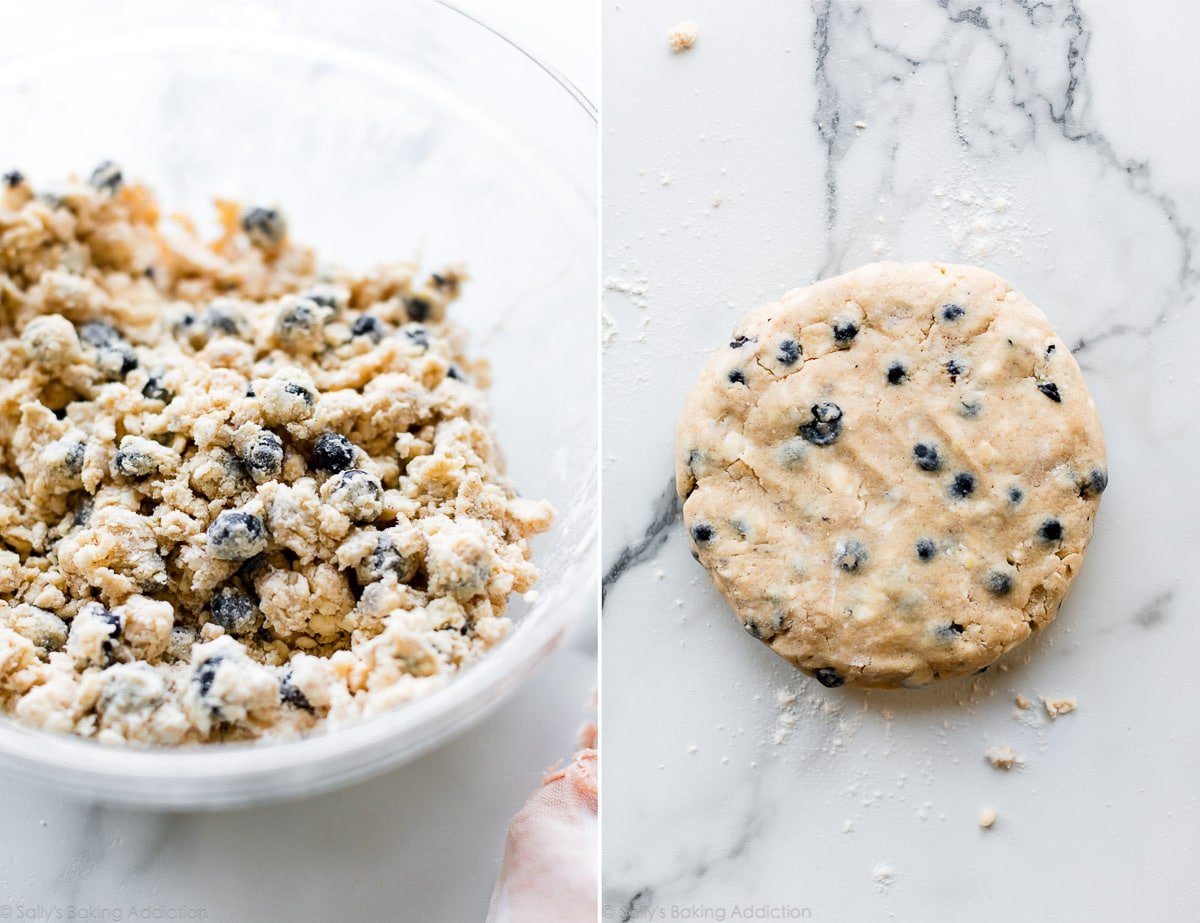

3 Tricks for Perfect Scones
If you take away anything from this post, let these be it!
- Heavy Cream or Buttermilk: Avoid thinner milks which yield a flatter, less flavorful scone. Canned coconut milk makes a wonderful nondairy option!
- Frozen Grated Butter: See above!
- Refrigerate Before Baking: Remember, cold dough is a successful dough. To avoid over-spreading, I recommend chilling the shaped scones for at least 15 minutes in the refrigerator before baking.
How to prevent flat scones: See #2 and #3. 🙂

How to Freeze Scones
I used to be totally against freezing scone dough. You see, the baking powder is initially activated once wet and if you hold off on baking, the scones won’t rise as much in the oven. However, the decrease in rise is so slight that it doesn’t make a noticeable difference. In fact, you can even shape this scone dough into wedges and refrigerate overnight before baking.
- Freeze Before Baking: Freeze scone dough wedges on a plate or baking sheet for 1 hour. Once relatively frozen, you can layer them in a freezer-friendly bag or container. Bake from frozen, adding a few minutes to the bake time in the recipe below. Or thaw overnight, then bake as directed.
- Freeze After Baking: Freeze the baked and cooled scones before topping with icing or confectioners’ sugar. I usually freeze in a freezer-friendly bag or container. To thaw, leave out on the counter for a few hours or overnight in the refrigerator. Warm in the microwave for 30 seconds or on a baking sheet in a 300°F (149°C) oven for 10 minutes.

15+ Scone Flavors
- Blueberry Scones and Chocolate Chip Scones (both pictured)
- Cranberry Orange and Pumpkin Scones
- Banana Scones and Lavender Scones
- Raspberry Almond Buttermilk Scones
- Lemon Blueberry Scones and Sprinkle Scones
- Caramel Apple and Cinnamon Chip Scones
- Triple Chocolate Scones – they taste like brownies!
- Strawberry Lemon Poppy Seed Scones
- Ham & Cheese Scones
- Mixed Berry (pictured): Follow recipe below and add fresh or frozen mixed berries. Raspberries and blackberries burst easily, so don’t go overboard on those.
- Cherry Chocolate Chip: Follow recipe below and add 3/4 cup semi-sweet chocolate chips and 3/4 cup chopped fresh or frozen cherries.
- Fresh Herb: Reduce sugar to 2 Tablespoons, leave out vanilla extract, and add 2 minced garlic cloves, 1/2 teaspoon ground black pepper, 1/2 cup chopped herbs such as rosemary, parsley, and basil. Additionally, feel free to add 1 cup shredded cheese to the dough and top with sea salt before or after baking!
Using the master recipe below as a starting point, toss in your favorite add-ins like white chocolate chips, toasted pecans, sweetened or unsweetened coconut, dried cranberries, peanut butter chips, etc. If it’s a particularly wet add-in like chopped peaches, blot them with a paper towel before adding to the dough. Top with lemon curd, raspberry sauce, or any of the suggested toppings below. Above all, have fun finding your favorite flavor!
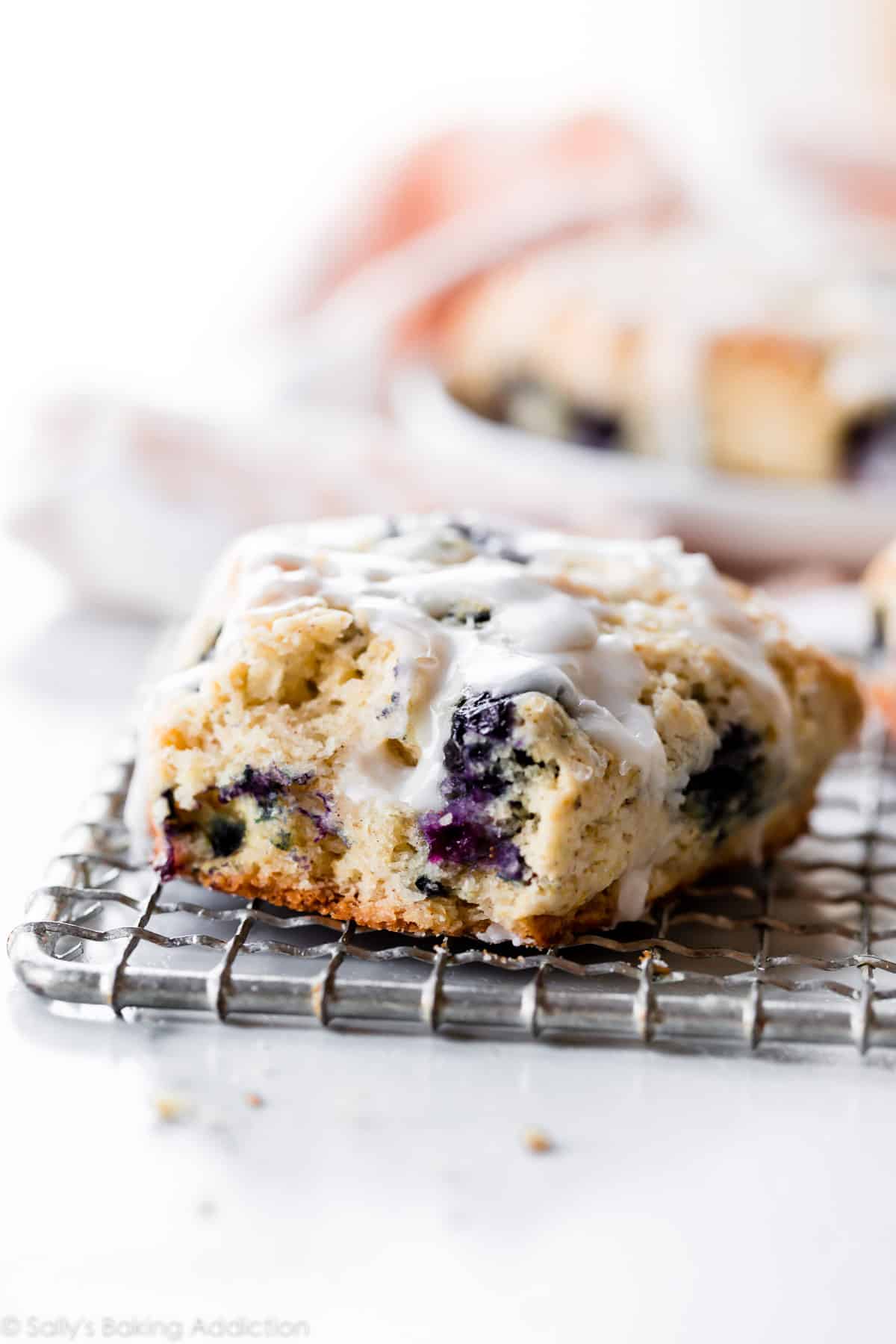
Look At All Of Your Scones!
Feel free to email or share your recipe photos with us on social media. 🙂
Print
How to Make Perfect Scones
- Prep Time: 30 minutes
- Cook Time: 25 minutes
- Total Time: 1 hour
- Yield: 8 large or 16 small scones
- Category: Breakfast
- Method: Baking
- Cuisine: American
Description
Use this basic scone dough for any sweet scone variety. See blog post for a couple savory scone options. Feel free to increase the vanilla extract and/or add other flavor extracts such as lemon extract or coconut extract. Read through the recipe before beginning. You can skip the chilling for 15 minutes prior to baking, but I highly recommend it to prevent the scones from over-spreading.
Ingredients
- 2 cups (250g) all-purpose flour (spooned & leveled), plus more for hands and work surface
- 1/2 cup (100g) granulated sugar
- 1/2 teaspoon salt
- 2 and 1/2 teaspoons baking powder
- 1/2 cup (1 stick; 115g) unsalted butter, frozen
- 1/2 cup (120ml) heavy cream or buttermilk (plus 2 Tbsp for brushing)
- 1 large egg
- 1 and 1/2 teaspoons pure vanilla extract
- 1–1.5 cups add-ins such as chocolate chips, berries, nuts, fruit, etc
- optional: coarse sugar for topping
Instructions
- Whisk flour, sugar, salt, and baking powder together in a large bowl. Grate the frozen butter using a box grater. Add it to the flour mixture and combine with a pastry cutter, two forks, or your fingers until the mixture comes together in pea-sized crumbs. See video above for a closer look at the texture. Place in the refrigerator or freezer as you mix the wet ingredients together.
- Whisk 1/2 cup heavy cream, the egg, and vanilla extract together in a small bowl. Drizzle over the flour mixture, add the add-ins, then mix together until everything appears moistened.
- To make triangle scones: Pour onto the counter and, with floured hands, work dough into a ball as best you can. Dough will be sticky. If it’s too sticky, add a little more flour. If it seems too dry, add 1-2 more Tablespoons heavy cream. Press into an 8-inch disc and, with a sharp knife or bench scraper, cut into 8 wedges. For smaller scones, press dough into two 5-inch discs and cut each into 8 wedges. To make 10-12 drop scones: Keep mixing dough in the bowl until it comes together. Drop scones, about 1/4 cup of dough each, 3 inches apart on a lined baking sheet. To make mini (petite) scones, see recipe note.
- Brush scones with remaining heavy cream and for extra crunch, sprinkle with coarse sugar. (You can do this before or after refrigerating in the next step.)
- Place scones on a plate or lined baking sheet (if your fridge has space!) and refrigerate for at least 15 minutes.
- Meanwhile, preheat oven to 400°F (204°C).
- Line a large baking sheet with parchment paper or silicone baking mat(s). If making mini or drop scones, use 2 baking sheets. After refrigerating, arrange scones 2-3 inches apart on the prepared baking sheet(s).
- Bake for 18-26 minutes or until golden brown around the edges and lightly browned on top. Larger scones take closer to 25 minutes. Remove from the oven and cool for a few minutes. Feel free to top with any of the toppings listed in the recipe Note below.
- Leftover scones keep well at room temperature for 2 days or in the refrigerator for 5 days.
Notes
- Freeze Before Baking: Freeze scone dough wedges on a plate or baking sheet for 1 hour. Once relatively frozen, you can layer them in a freezer-friendly bag or container. Bake from frozen, adding a few minutes to the bake time in the recipe below. Or thaw overnight, then bake as directed.
- Freeze After Baking: Freeze the baked and cooled scones before topping with icing or confectioners’ sugar. I usually freeze in a freezer-friendly bag or container. To thaw, leave out on the counter for a few hours or overnight in the refrigerator. Warm in the microwave for 30 seconds or on a baking sheet in a 300°F (149°C) oven for 10 minutes.
- Overnight Instructions: Prepare scones through step 4. Cover and refrigerate overnight. Continue with the recipe the following day.
- Special Tools (affiliate links): Glass Mixing Bowls | Box Grater | Pastry Cutter | Whisk | Rubber Spatula | Bench Scraper | Baking Sheet | Silicone Baking Mat or Parchment Paper | Pastry Brush
- Scone Flavors: See blog post above. If adding fruit, use fresh or frozen. If frozen, do not thaw. Peel fruits such as apples, peaches, or pears before chopping. If desired, add 1 teaspoon of cinnamon with the flour. I usually add cinnamon when making chocolate chip scones.
- Over-spreading: Start with very cold scone dough. Expect some spread, but if the scones are over-spreading as they bake, remove from the oven and press back into its triangle shape (or whatever shape) using a rubber spatula.
- Mini/Petite Scones: To make smaller scones, press dough into two 5-inch discs and cut each into 8 equal wedges. Bake for 18-20 minutes or until lightly browned.
- Optional Toppings: Vanilla icing, salted caramel, lemon icing from this iced lemon pound cake, maple icing from these banana scones, brown butter icing from these pistachio cookies, lemon curd, orange icing from these hot cross buns, raspberry icing from these mini pound cakes, dusting of confectioners’ sugar.
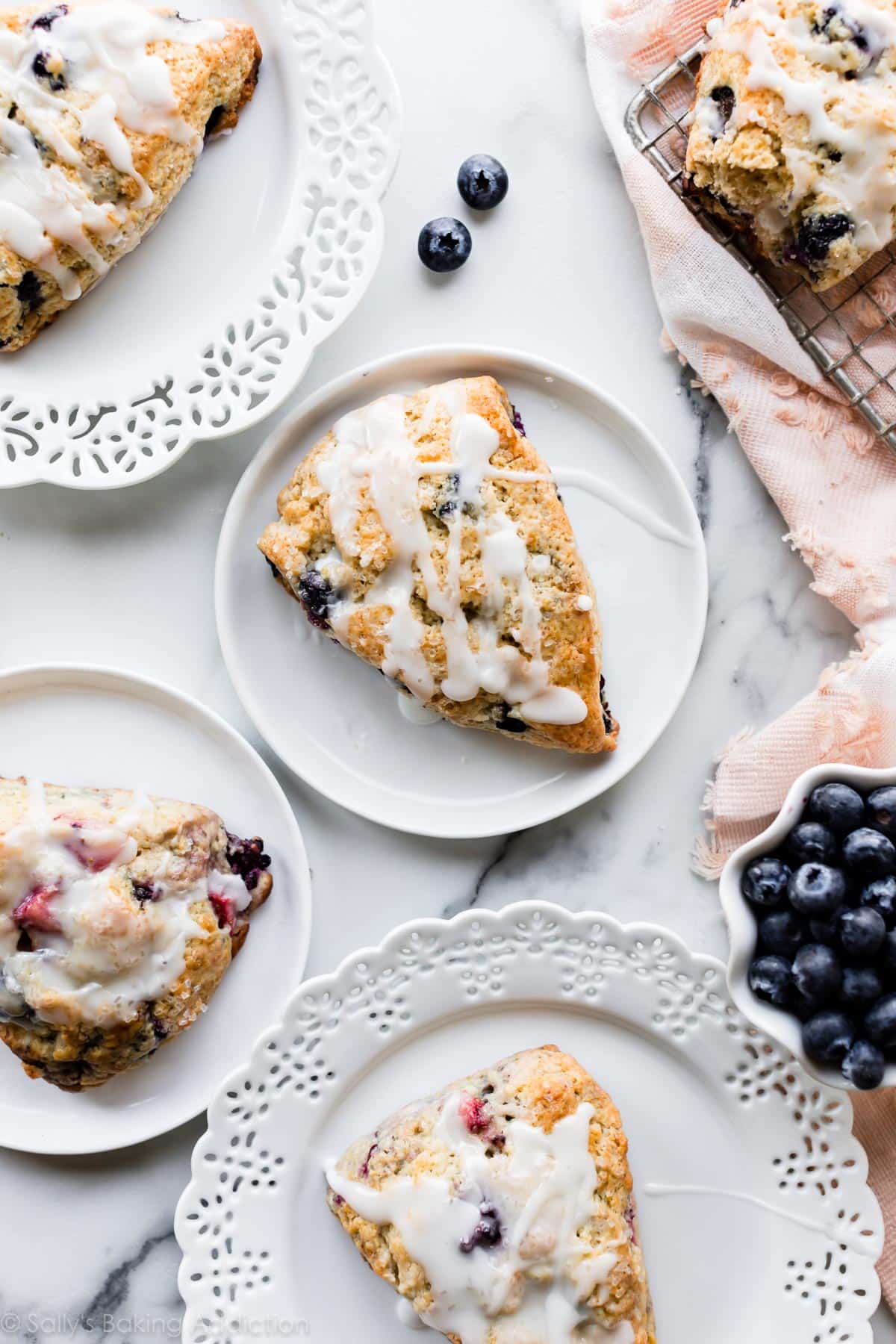


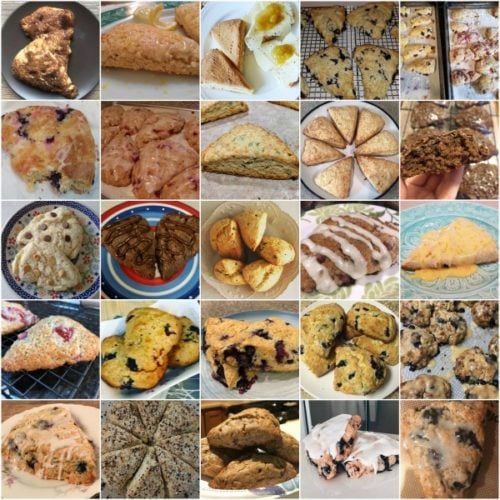

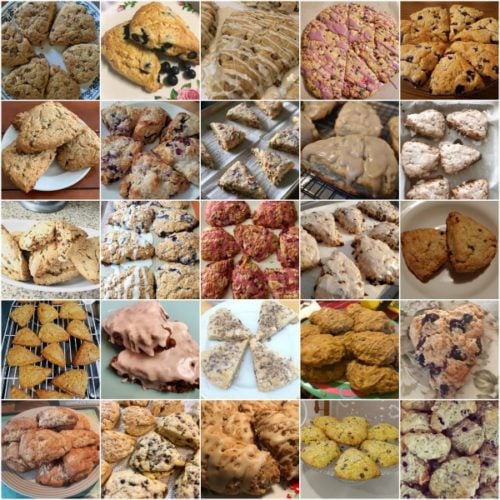










































First time making scones. Delicious. I’m hooked
So glad you love them!
My go to recipe! I have tried so many different add ins and they are always perfect. Sweet or savory!
I followed this recipe to a T, and baked scones for a group of 50 people. They gave me RAVE reviews! I’ve been baking for them weekly for the last 8 weeks, and this is the first time that people really said WOW. These scones are definitely going into my rotation!
I love making scones…especially this recipe. I have one problem I am hoping oyu can help me with. I seem to get very brown edges…sometimes close to burned edges…no matter the flavor.
Any suggestions on how to get a better, more even bake for the bottom and edges? Also, any chances you could develop a gingerbread scone recipe?
Hi Nancy, we’re so glad this recipe is a favorite for you! It might help to move your pan down a rack away from the heating element, or baking them at a lower temperature (knowing that bake time will be a bit longer). Do you have an oven thermometer? You might find that your oven runs a bit hotter than it’s reading, too. We’ve never tested a gingerbread scone before. You could try adding spices and molasses, and reducing the liquid and sugar, but it would definitely take some testing to get right. Let us know if you give it a try or find a recipe you love!
Hi Sally! Mine came out great, added dried apricots & fresh apple. Topped with brushed buttermilk(really makes them pretty & a nice crunch) and cinnamon sugar/Sliced Almonds, Awesome, Thanks, Fleck (Wanted to send a pic but can’t figure attachments.)
This is Ina Garten’s recipe word for word. At least give credit.
Her English Cream Scones, or Cranberry Orange Scones? I see differences in both. I developed this recipe in 2014, from a class I took at Panera Bread’s headquarters. When I adapt a recipe from a chef or cookbook, I will give proper credit. I understand the work that goes into recipe development. Thank you for your feedback, though.
Hi Amy! We’d love to help but we are not trained in baking with sugar substitutes. For best taste and texture (and so you don’t waste your time trying to adapt this recipe since it may not work properly), it may be more useful to find a recipe that is specifically formulated for sugar substitutes. Thank you!
I made these a week ago, and they were perfect! But this week, I baked them for 18 minutes and they weren’t quite done, so I added 4 minutes and the bottoms turned to charcoal. Any ideas? I followed directions to a T. Sides were browned and tops barely had any color. I cut off the char, and the tops were perfect!
Hi Sarah! Maybe try a different position in your oven? Strange that they would bake so unevenly.
Instead of round I make mine about 3-4 inches wide and about 1 inch wide. They fit perfect into a plastic container.
I follow all the steps of freezing the butter, use cold cream, and freeze the scones while the oven is preheating, yet they still over-spread a little. Any advice?
Hi Alexandra! Some spreading is normal. You can try freezing the scones for longer before baking or adding a tiny bit more flour. If you notice the scones spreading while they bake, you can use a spatula to gently press them back into shape.
Does anyone know if half & half or condensed milk work in this recipe as a substitution?
Hi Liv, you can use half and half here. Enjoy!
I can attest to yogurt, which I thinned slightly with milk. These are fab!
Awesome recipe, as usual.
Can I use brown sugar instead of regular granulated sugar and add some ground cardamom to this recipe?
Absolutely.
This is a favorite of mine! Do you think I could refrigerate the dough for two nights and it still be fine?
You certainly can, but the scones may not rise/expand quite as much. I would say 24 hours is the limit, for the best results. So glad that you enjoy this recipe.
I’ve made this recipe repeatedly for my friends. My only adjustment is to use closer to 3/4 cup buttermilk, but they turn out perfect every time. Thanks!
Can I use almmod flour for this recipe to make gluten free scones?
Hi Natalie! We don’t recommend almond flour as it has very different baking properties and is not usually a 1:1 swap. We haven’t tested it, but you might have success experimenting with a gluten-free all-purpose flour like Bob’s Red Mill or Cup4Cup. If you give anything a try, we’d love to know how it goes for you!
I’ve been making these with King Arthur gluten free Measure-for-Measure and they are delicious! A little more fragile than with regular flour but still amazing.
This was the first time I’ve made scones and they came out beautifully. They spread a bit, but not too much. I cooled the pre-cooked slices in the refrigerator for 10 minutes, then popped them into the freezer for the last 5 minutes. Next time, I may extend the freezer timing to 10 minutes to minimize the spread a bit so as to make the scones a little neater looking……Otherwise, they were perfectly browned on the outside and soft and flaky inside, and SO decadently delicious…..I made the large version as described here, and it finished in 18 minutes @ 400F in an electric oven.
Once upon a time Starbucks made a Maple Oat Scone. I’d love to have that recipe.
Holy Hannah! Knock-your-socks-off scones! This was the first recipe I’ve ever used to make scones, and I was not disappointed! These are fantastic! No point in trying other scone recipes when this one is perfect! Easy to follow steps and the scones turned out divine. Now I just need to figure out how to stop eating them…
Everything I make from your site is delicious.
I just love this recipe! So adaptable! We picked wild cranberries last week and I’ve been excited to make scones all week for Saturday breakfast but realized this morning we were out of cream And milk! I subbed plain yogurt and they turned out divine. White chocolate wild cranberry scones with orange zest.
Followed exactly but added dried apricots and absolutely LOVED it! Fluffy and delicious straight out of the oven!
Wow. Baked fresh in Australia this afternoon and they went in a heartbeat over coffee. Have already forwarded the recipe to friends and family (hesitantly). Thanks Sally.
Can I make Buttermilk whole milk and lemon?
Hi Donna, yes, you can make a DIY buttermilk with whole milk and lemon juice here. Add 1 teaspoon of lemon juice to a liquid measuring cup. Then add enough whole milk to the same measuring cup until it reaches 1/2 cup. Stir it around and let sit for 5 minutes. The homemade “buttermilk” will be somewhat curdled and ready to use in the recipe.
Recipe is pretty good. Felt that it needed a lot more butter than recipe calls for. Had a more bread like texture than a stiffer crumble. Perhaps I’m comparing it to a European style scone that’s more like a crumbly biscuit texture. Either way it risen quite well. I used whole milk instead of cream or buttermilk. The outside crunch was very nice. I also used milk to brush the top before baking which made it have a beautiful shiny golden color.
This was a great recipe…added a half cup of orange marmalade and half cup of orange juice (a little more flour to make it the right consistency) then glazed with confectioners sugar with the zest and milk…were soft and delicious! Perfect!
Flavor is great on these however mine spread into one giant blob. I froze my butter first, and refrigerated the dough overnight. Not sure why this didn’t work for me.
Hi Jess we’re happy to help troubleshoot! Did you use full fat heavy cream? Anything thinner will cause the scones to spread.
Will they be okay if the pre baked dough is frozen for a couple weeks?
Hi Lucia! Baked scones freeze well – see recipe notes for details.
What an amazing recipe. I baked the items in a mini scone pan and they came out beautifully.
The recipe came out more like a muffin top. I’ve made scones thousands if times and usually rely on my favorite recipe. Today I ventured outside the box and was not happy unfortunately. They’re moist, nit sweet enough by any means..even for a scone and again they’re flat like thick pancakes. Wouldn’t recommend
This recipe is amazing! Followed the directions to a T, and they are the best scones ever. I do wonder if I could use bread flour instead of all-purpose, or if I should adjust the amount of baking powder if I do.
Hi Sarah, you can certainly try bread flour in this recipe. The scones may taste chewy and a little more dense. All-purpose flour is best.